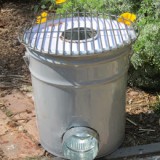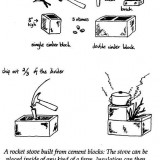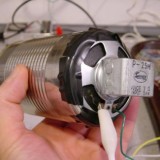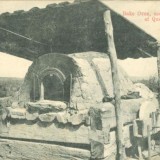
Update: Root Simple reader Ruben questions whether it is possible to build a true rocket stove out of metal. Ruben sent me to a Facebook post by Benjamin Rosen who says, speaking of another metal rocket stove, “Actually, you can say that this is not a rocket stove. A rocket stove gives great heat from a small amount of fuel because it burns very efficiently at high temperatures. This is achieved by having a ceramic lining in the combustion chamber that permits very high temperatures because it insulates the combustion chamber, and because it absorbs and returns the heat to the chamber by glowing white hot. A metal lining, as we see in this design, will shed heat to the environment and therefore cannot reach the high temperatures needed for a true rocket stove. Metal, in any case, would melt at the temperatures achieved in a true rocket stove combustion chamber.“
Rocket stoves cook food with small pieces of wood efficiently and with much less smoke than conventional wood burning stoves. They also help prevent deforestation since you can burn small twigs trimmed off a tree rather than burning logs. Search the interwebs and you’ll find may different designs. But they are all based on burning wood in an “L” shaped tube to create a chimney effect. Insulating the tube increases efficiency.
A friend who lives in a remote part of Southeast Asia is visiting us this month and we wanted to come up with a design for a rocket stove that could be made from commonly available materials with nothing more than hand tools. Our goal was done rather than perfect. Here’s how we did it:

We settled on a simple design, using just a metal paint can, some sheet metal and nuts and bolts: supplies that can be found in the small village he lives in. As for tools we used a pair of tin snips, a pair of pliers, a nail, a hammer and a pocket knife.

The first step was to size the pipe and the holes we would need to cut in the paint can. According to the Aprovecho Institute, the height of the rocket stove should be no less than three times the diameter of the pipe. Make the pipe higher and you’ll cut down on smoke but lesson efficiency. Since the paint can we had was around 19 cm tall, we decided to make the tube around 6.3 cm.

The first cut was made in the top lid of the can.

We used a nail and hammer to make a hole for the tin snips.


We used a pair of pliers to bend over the rough bits of the metal. Again, our goal was to make something cheaply and quickly.

Next we cut a 6.3 cm hole in the bottom of the paint can.

Then it was time to fashion a tube out of sheet metal. In the US, it would be a lot easier to use stove pipe material, but it’s much easier to find sheet metal in the part of India my friend lives in.

We rolled the sheet metal into tubes.

We cut a slit in the vertical tube so that the horizontal tube could be inserted into it to form an “L”. It’s not a perfect fit, but with the insulation we added later, it works.

One of the problems with a lot of improvised rocket stoves is figuring out a way to hold the pot over the vertical tube. I realized that we could use five bolts and ten nuts to improvise a stand. We cut the first hole using a nail and tin snips.

We broke our “no power tool” rule to speed up the process.

Here is the top of the can with the bolts and nuts that will hold the pot just above the vertical tube where the heat comes out.

We inserted the horizontal tube and cut a notch out of the end, leaving a kind of shelf to hold the sticks we’ll use as fuel. This shelf ended up being a good idea.

We cut another piece of sheet metal to act as a pot shield. This increases the efficiency of the oven and channels heat around the sides of the pot. Jokes were made about Frank Gehry as we wrapped the shield around the can.

Rocket stoves work better if you insulate the pipe. We used wood ash for this purpose but you could also use vermiculite. The wood ash also sealed up the gaps in our sloppy sheet metal work.

We got the fire going with a small piece of paper and used twigs as fuel.


With the shield in place the stove boiled 8 cups (1.8 liters) of water in around 26 minutes with a surprisingly small amount of fuel.
If I were to build a rocket stove for daily use I’d want a larger pipe and can to enable burning larger pieces of wood. Another option would be to cast a stove out of refractory cement. I’ve built a similar rocket stove out of a five gallon bucket, but metal five gallon buckets are harder to find. I’ve also used bricks to make a rocket stove. If you know how to weld a world of other design options are open to you.
Do you have a favorite rocket stove design? Leave a comment!







I have a bit of a rambling story—but stick with me, I will get to rocket stoves soon.
I grew up in an underground, passive solar house in BC’s Okanangan. The house varied between too hot and tool cold, and I never could understand why. After all, wasn’t it all of the good things?
Rocket stoves helped me understand.
Rocket stoves can be efficient and cleaner burning when they burn wood at very high temperatures. The high temperatures actually reburn gases and pollutants, extracting more heat and reducing particulates and poison gases.
The high temperature burn is the thing though. This is achieved through the careful design of the burn chamber, the control of the air flow, and especially, with insulation.
Insulation is chronically confused with thermal mass—hence my cold childhood home.
MASS:
Concrete
Cob
Brick
Soil
Adobe
INSULATION:
Wood ash
Roxul
Foam
Straw bale
Vermiculite
Mass soaks up heat and releases it slowly. Insulation tries to prevent heat from moving in the first place.
So an uninsulated cob or underground home soaks up a lot of heat, and can just keep releasing that heat to the earth and the air. This is great in a hot desert climate, but is much less pleasant in a cooler and damper climate.
What this means, is if you build your rocket stove out of mass, you will never get the high burn temperatures to use fuel efficiently or avoid airborne pollutants.
Well-designed mass heaters ALL have a well-insulated firebox for the hot, clean burn, and a circuitous mass chimney for the heat collection and slow release.
So, when you see rocket stoves built of cob, rocks or uninsulated steel, they are crap. You need insulation around the burn chamber.
And that is about the extent of my expertise. But a friend posted a video of an uninsulated steel “rocket” stove on facebook, and I made a snarky comment. Someone else left an interesting reply:
“Actually, you can say that this is not a rocket stove. A rocket stove gives great heat from a small amount of fuel because it burns very efficiently at high temperatures. This is achieved by having a ceramic lining in the combustion chamber that permits very high temperatures because it insulates the combustion chamber, and because it absorbs and returns the heat to the chamber by glowing white hot. A metal lining, as we see in this design, will shed heat to the environment and therefore cannot reach the high temperatures needed for a true rocket stove. Metal, in any case, would melt at the temperatures achieved in a true rocket stove combustion chamber.”
Metal would melt at the temperatures achieved in a true rocket stove.
https://www.facebook.com/javan.bernakevitch/posts/10156542261135230
Thanks Ruben–this is very interesting–I need to go back to the drawing board and come up with a ceramic version.
I purchased a rocket stove last year to have on hand in the event of a major ice storm / week long power outage. Played with it last summer, but haven’t “needed” it yet. I made a dutch oven full of slow cooked chili on it that took very little fuel over 2-3 hours. I was impressed. In a pinch, it will be a really useful technology.
Interesting! I always thought the term ‘rocket’ came from the secondary burn, which makes the stove sound like, well, a rocket. I didn’t know that a specific design/burn temperature was part of the equation. I’ve never had a white-hot burn chamber in stoves I’ve built (for the reasons Ruben mentions), but I definitely get the rocket sound from the secondary burn.
In your case, you insulated it with wood ash anyway, so it seems like your stove would make it qualify by Ruben’s criteria, too. You do lose some heat along the axis of your sheet metal tube, but the wood ash insulation probably helps you keep most of it. How hot is the outside of the paint can while it’s burning? That would give you some idea of how well-insulated you are.
For rocket stove designs, I’m partial to the Dakota-style stove and the pocket rocket stove in my yard, but one that’s really intriguing to me is the Dasifier (description here, grainy-but-useful video here). The Dasifier isn’t naturally drafting, but it can melt bronze (i.e., it can go over 1000 °C), which I think is pretty cool.